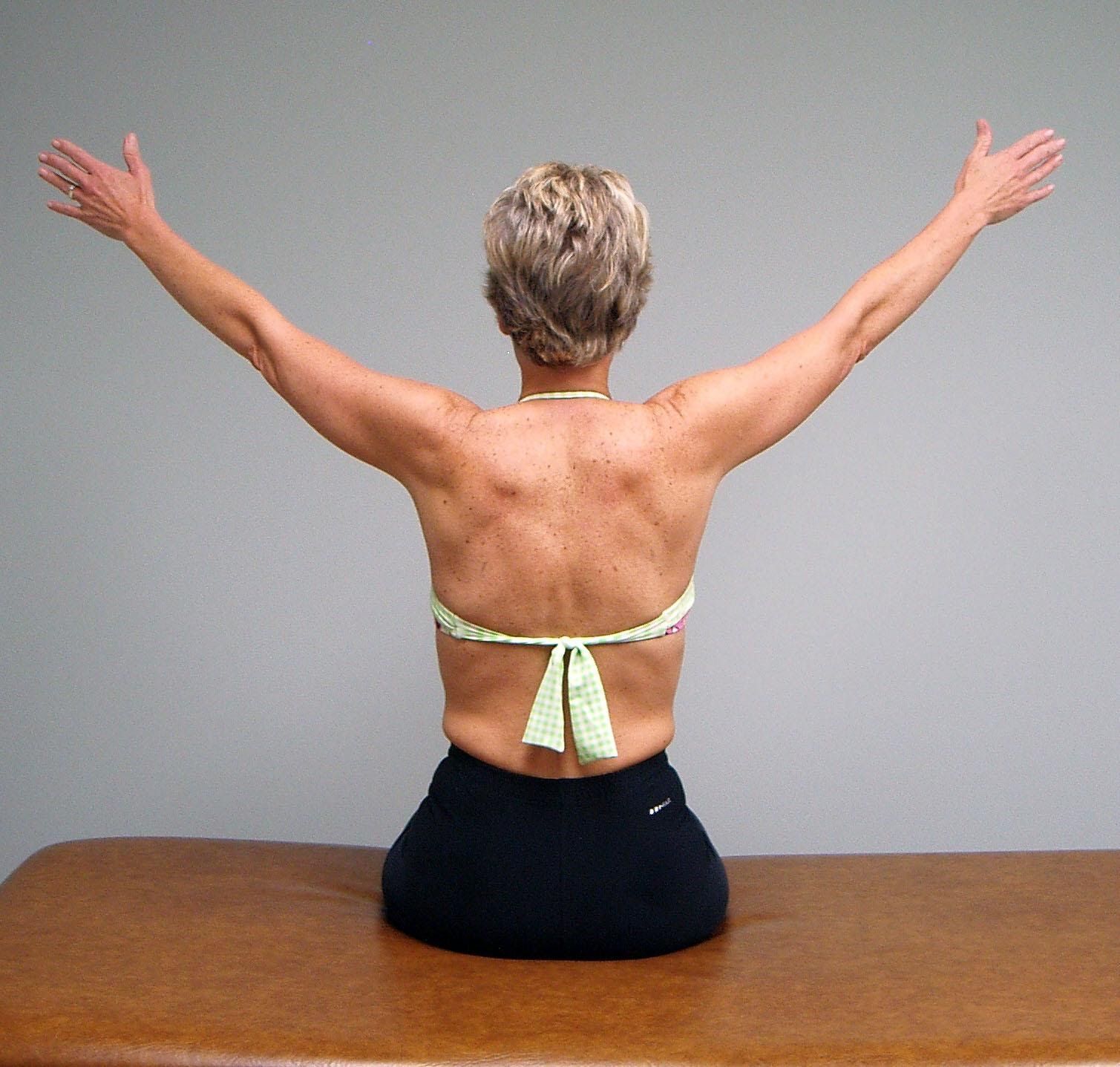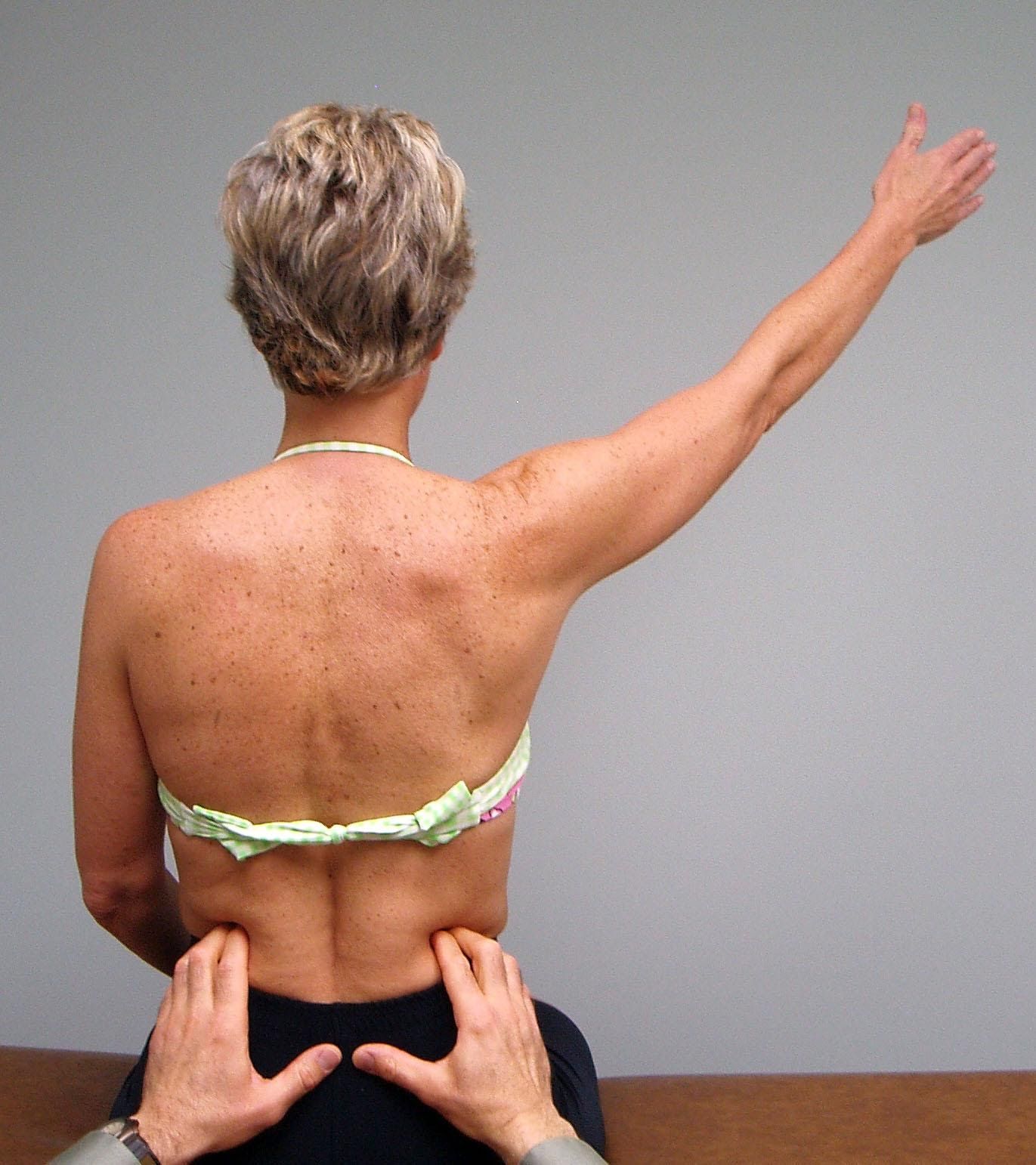Shoulder Abduction Test
- The patient is seated and instructed to raise the arms out to the sides and overhead.
- The therapist observes for any faulty substitution patterns while the patient raises and lowers the arms.
- Notice that this patient, who was complaining of right shoulder pain, elevates and excessively upwardly rotates the right scapula indicating a loss of scapular stability and dysfunctional biomechanics for right shoulder abduction.
- After observing bilateral shoulder abduction the patient is asked to raise one arm at a time with the examiner palpating the quadratus lumborum muscles bilaterally for appropriate firing. During right shoulder abduction the left quadratus lumborum should fire, especially at about 120 degrees of abduction to offset the weight of the right arm. If the right quadratus lumborum fires while raising the right arm it indicates an abnormal/dysfunctional muscle firing pattern. The patient is then forced to compensate by elevating the shoulder girdle with the upper trapezius and levator scapula muscles which become hypertonic and shortened.
Interpretation and the most common dysfunctional patterns seen
Janda, 1990 described a normal sequential shoulder abduction firing pattern occurring as follows:
- supraspinatus
- deltoid
- contralateral and ipsilateral upper trapezius/levator scapulae
- contralateral quadratus lumborum
- contralateral peronei
He did not mention the role of the serratus anterior or lower trapezius muscles. Elevation of one shoulder girdle during the test and/or scapular winging may be due to a muscular imbalance between the levator scapulae and upper trapezius which are hyperactive and tight and inhibition of the lower trapezius, serratus anterior and supraspinatus which appear to be weak. EMG analysis of the three divisions of the trapezius muscle during isokinetic shoulder abduction has shown that the upper trapezius activity is increased whereas the lower trapezius activity is decreased in overhead athletes with a history of shoulder impingement when compared to a control group of non-injured athletes (Cools et al., 2007). It has also been reported that shoulder impingement patients have delayed firing of the middle and lower trapezius during sudden perturbations of the shoulder compromising the functional stability of the scapula (Cools et al., 2003).
We have observed that overutilization of the upper trapezius and levator scapulae may also occur when the ipsilateral rather than contralateral quadratus lumborum fires limiting the patient’s ability to elongate the spine on that side resulting in excessive compensatory superior translation of the scapula during abduction of the shoulder.
Normally during shoulder abduction the scapula upwardly rotates, externally rotates and posteriorly tilts (Ludewig, Cook, Nawoczenski, 1996), occurring as a result of a force coupling involving the upper and lower trapezius and serratus anterior. Lukasiewicz et al., 1999 reported that when comparing subjects with signs and symptoms of shoulder impingement to an asymptomatic matched control group that the impingement patients presented with a decrease in posterior tilting during humeral elevation with excessive scapular superior translation. Interestingly, they did not find a difference in the amount of upward rotation between the two groups. Based upon their findings they proposed that exercise programs for shoulder impingement patients should probably include stretching of the pectoralis minor and strengthening of the serratus anterior to address this loss of posterior tilt.
Therefore, it is well known that when the lower trapezius and serratus anterior are inhibited/weak there is a loss of not only scapular stability, but also all three planes of normal scapular mobility during humeral elevation. Hyperactivity of the levator scapula and upper trapezius results in elevation, downward rotation and anterior tilt of the scapula. Hyperactivity of the pectoralis minor protracts, internally rotates and anteriorly tilts the scapula.
We propose that a strain of the cervical spine occurs due to the hypertonicity of the levator scapula muscle as it attaches to the upper four cervical segments. Stretching the levator scapula not only reduces the strain in the neck, but, if properly done, allows posterior tilting of the scapula to occur unimpeded during shoulder elevation.


